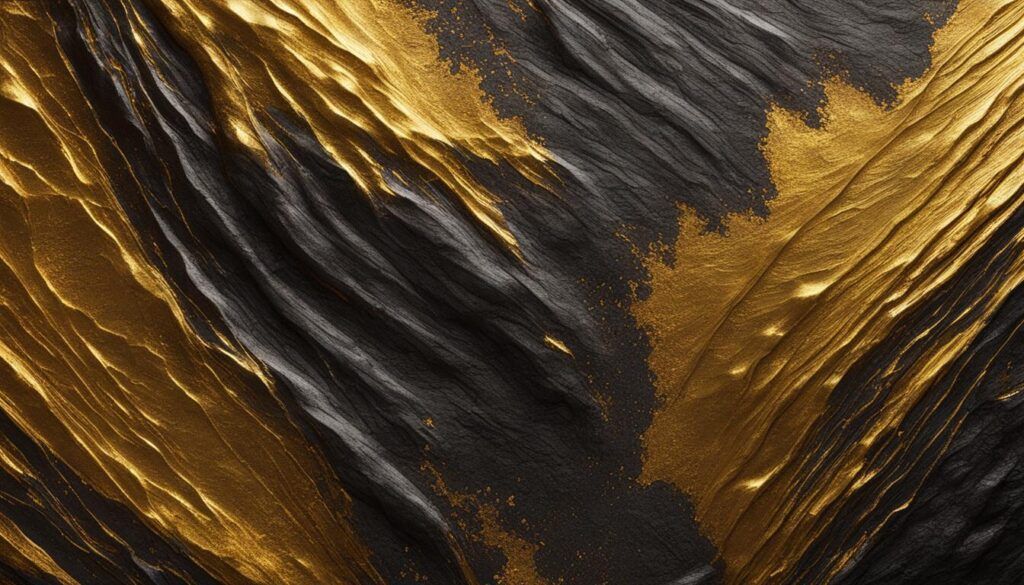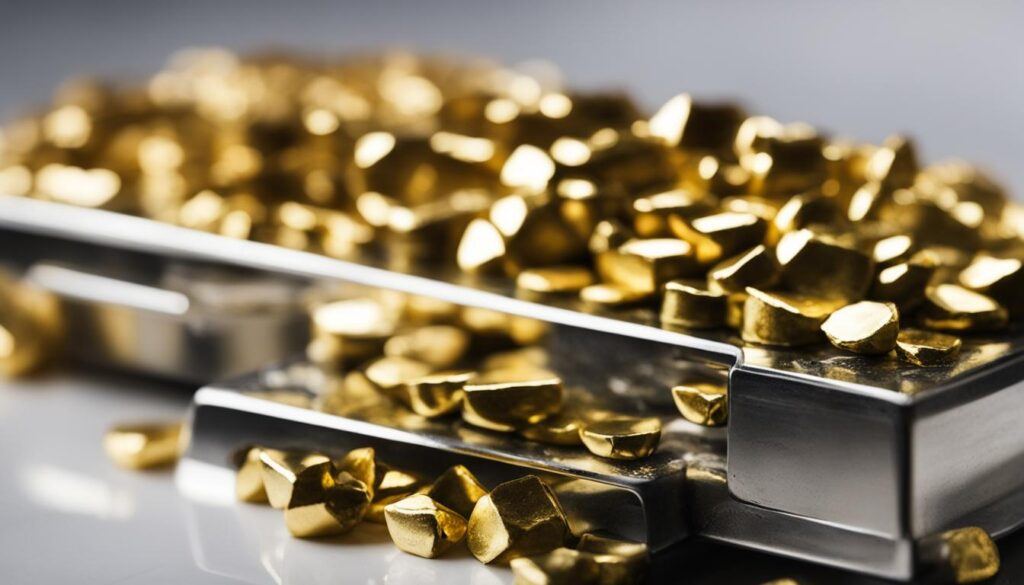You may wonder:
- Where does the purest gold come from?
- Where on Earth can you find the natural deposits of this yellow metal?
When it comes to finding the purest gold on Earth, there are several locations around the world that stand out for their exceptional quality and richness.
These gold mining sites are renowned for their high purity and serve as the primary sources for extracting the highest quality yellow metal.
One of the notable locations is the Crisson Mine in Georgia, United States. Operated by the Crisson family for four generations, this historic mining site has been open to the public since 1969.
The Crisson Mine is known for its rich deposits of gold-bearing quartz, which contain some of the purest gold found on Earth.
With a purity of 98.7 percent, the yellow precious metal extracted from this site ranks among the highest quality sources available.
Key Takeaways:
- The Crisson Mine in Georgia, United States is known for their rich deposits of gold-bearing quartz and is one of the best places to find pure gold with a purity of 98.7 percent.
- Earth’s purest yellow metal deposits can be found in locations with high-quality gold sources.
- The Crisson Mine has a rich history of gold mining and has been operated by the Crisson family for four generations.
Without further ado, let’s get started.
Investing in the U.S.? Our #1 Recommended Gold IRA Company
The Crisson Mine – A Legacy of Gold Mining in Georgia
The Crisson Mine, located in the state of Georgia, is an iconic gold mining site with a rich history and a reputation for producing some of the purest gold in the world.
As the oldest gold panning establishment in the state, the Crisson Mine holds a special place in Georgia’s gold mining history.

The Crisson Mine opened its doors to the public in 1969, allowing visitors to experience the fascinating world of gold mining firsthand.
But the mine’s history dates back much further. Gold was first discovered at the site in 1847, setting off a gold rush in the area.
“The Crisson Mine is a testament to the rich gold mining heritage of Georgia. It has witnessed the highs and lows of the industry and continues to be a popular destination for gold enthusiasts, offering them a chance to pan for gold and learn about the mining process.”
The Crisson Mine is renowned for its gold-bearing quartz veins, which are found throughout the open pit.
These veins contain a high concentration of gold, making the mine a significant source of this precious metal. In fact, the mine boasts twenty-two different gold-bearing veins of quartz, each contributing to the production of pure gold.
The Purest Gold in the World
| Gold Purity | Gold Grade |
|---|---|
| 98.7% | Over 23KT |
The gold found at the Crisson Mine is revered for its exceptionally high purity.
With a gold purity of 98.7 percent, the Crisson Mine produces gold that surpasses the industry standard. This remarkable purity level, equivalent to over 23KT gold, makes it one of the purest sources of gold in the world.
Dubai – The City of Gold and Its High Purity Gold Market
The Emirate of Dubai in the United Arab Emirates (UAE) is known as the City of Gold and is home to one of the world’s most famous and high purity gold markets.
Dubai boasts the highest purity levels in its gold, with the gold produced and sold in the city known for its exceptional purity.
One of the best locations to purchase gold in Dubai is the Dubai Gold Souk.
This traditional market is a labyrinth of shops and stalls offering a wide variety of gold jewelry, from intricate designs to modern pieces.
The Gold Souk is a popular destination for both residents and tourists alike, known for its exquisite craftsmanship and high quality.
Another prominent gold hub in Dubai is the Gold & Diamond Park, a modern complex dedicated to gold and diamond jewelry.
The park showcases a range of luxury brands and designers, making it a preferred destination for those seeking high-end gold pieces.

The gold produced and sold in Dubai is known for its exceptional purity, making it a top choice for gold enthusiasts and investors.
Dubai’s gold purity levels are a testament to the stringent standards and regulations in place to ensure the authenticity and quality of this yellow metal sold within the city.
Dubai is committed to maintaining its reputation as the purest gold marketplace in the world.
Dubai – A Unique Gold Shopping Experience
One of the remarkable aspects of purchasing gold in Dubai is the diverse range of options available.
Whether you are looking for traditional designs, contemporary styles, or customized pieces, Dubai’s gold market caters to every taste and preference.
In addition to the Gold Souk and the Gold & Diamond Park, Dubai is home to a variety of other gold retailers, including prestigious international brands and local jewelers.
These establishments offer a wealth of choices, ensuring that customers can find the perfect piece of gold jewelry.
On top of that, Dubai’s gold market offers a transparent and secure shopping experience.
The gold sold in Dubai is affordable, verified for purity, and buyers can trust that they are purchasing genuine and high-quality gold.
Dubai – Investing in High Purity Gold
Aside from being a popular destination for gold jewelry, Dubai is also a thriving gold investment hub. The city offers various options for investing in gold, including gold bars and coins.
Investors are drawn to Dubai’s gold market due to its reputation for high purity, and transparency.
Gold purchased in Dubai carries the assurance of quality, making it an attractive choice for those looking to invest in this precious metal.
| Benefits of Dubai’s Gold Market | Why Choose Dubai for Gold Shopping |
|---|---|
| Exceptional purity levels | A wide range of options |
| Transparent and secure shopping experience | Genuine and high-quality gold |
| High reputation for gold investment | Assurance of quality |
Dubai’s gold market continues to attract precious metal enthusiasts and investors from around the world.
The city’s commitment to high purity standards and its reputation as the City of Gold make it a top destination for those seeking the purest gold in the market.
Countries Known for Producing High-Quality Gold
When it comes to high-quality gold with exceptional purity levels, several countries stand out as top producers.
These are known for their commitment to producing pure gold and have established reputations in the global precious metal market.
Bangkok, Thailand
In Bangkok, Thailand, gold jewelry is highly regarded for its purity.
The gold jewelry produced in Bangkok has a remarkable purity level of 96.5%. This makes it a popular destination for individuals seeking pure gold jewelry.
(And Thai gold is cheap.)
Zurich, Switzerland
Zurich, Switzerland, is renowned for its high-purity gold jewelry, coins, and bars.
Swiss gold is considered to be of exceptionally high quality, with stringent purity standards upheld throughout the country. The gold produced in Zurich is highly sought after by collectors and investors.
Hong Kong, China
As the world’s largest producer of gold, Hong Kong, China, boasts an extensive range of high-quality gold bars and jewelry.
Hong Kong’s gold production is known for its high purity levels, making it a favored destination for those seeking pure gold products.
Cochin, India
In Cochin, India, gold is deeply valued and holds great cultural significance.
The yellow metal produced in Cochin is known for its high purity levels, reflecting the importance of gold in Indian traditions and customs.
Cochin members place a strong emphasis on obtaining pure gold.
Dubai, UAE
Dubai, UAE, is renowned for its exceptional high-purity gold.
The city has a flourishing market and offers an impressive range of precious metal products with outstanding purity levels.
Dubai is a destination of choice for those seeking gold of the highest quality, at a better price.
These countries have established themselves as leaders in producing high-quality gold with exceptional purity levels.
Whether you are looking for exquisite gold jewelry or solid gold investments, these countries are known for their commitment to excellence in gold production.

Countries Known for Producing High-Quality Gold
| Country | Gold Purity |
|---|---|
| Bangkok, Thailand | 96.5% |
| Zurich, Switzerland | High purity standards |
| Hong Kong, China | High-purity gold bars and jewelry |
| Cochin, India | High purity levels |
| Dubai, UAE | Exceptional high-purity gold |
Comparison of Gold Purity by Country
The purity standards vary by country and are influenced by factors such as tradition, cultural trends, and economic factors.
Let’s take a closer look at the purity levels of this yellow metal in different countries:
North America
In North American countries like the United States, Canada, and Mexico, the norm for gold purity is typically between 14 to 18 karats.
These countries have a long history of gold production and adhere to international purity standards.
Europe
European countries generally consider the gold standard between 14 and 18 karats as well.
This standard is widely accepted and ensures the gold’s durability and quality. European jewelers have mastered the art of creating stunning gold jewelry pieces with precise purity levels.
READ ALSO: Is Italian Gold Good?
Asia
Asian countries like India, China, and Turkey have higher purity standards when it comes to gold.
India, renowned for its exquisite gold jewelry, typically showcases gold with an average purity of 22 karats.
China’s yellow metal sets the bar high with a requirement of no less than 24 karats for gold. Turkish gold is also highly prized for its purity.
These varying purity standards across different countries highlight the diverse preferences and cultural significance of gold across the globe.
Historical Trends in Gold Purity
Humans have had a deep fascination with gold since ancient times, as it symbolizes wealth and power.
Throughout history, civilizations devised methods to test the purity of gold, ensuring its authenticity and value.
Ancient gold purity methods included techniques like fire assaying and touchstone testing, which involved subjecting gold to heat or rubbing it against a stone to observe its color and reactions.
In the modern era, the demand for gold with high purity remains strong.
Countries like India, Dubai, and China have emerged as major producers and importers of gold with a purity above 90%.
For instance, India is renowned for its demand for 999.99 gold, which signifies gold with a purity level exceeding 99.99%.
“Gold has been a symbol of wealth and power throughout history, and it continues to be highly valued today.” – Gold enthusiast
The use of high-purity gold extends beyond its aesthetic appeal.
In industries such as electronics and dentistry, where purity is crucial, fine gold is highly sought after.
It provides exceptional conductivity and corrosion resistance, making it an ideal material for delicate electronic components and dental restorations.
The Allure of Pure Gold
Pure gold’s timeless appeal is deeply ingrained in our culture.
It has not only served as a form of currency and a means of exchange but also holds immense cultural significance. From ancient civilizations to modern societies, gold has been treasured and passed down through generations as a valuable asset.
Today, gold purity testing techniques have become more advanced, allowing for precise measurements and accurate certifications.
Independent laboratories and institutions conduct thorough assessments, ensuring that gold meets the specified purity standards.
| Benefits of Pure Gold | Industries that Utilize Pure Gold |
|---|---|
|
|
As gold continues to captivate us with its allure, it’s essential to understand its historical trends and the methods used to determine its purity.
Ancient techniques paved the way for modern gold purity testing, which ensures the integrity and value of this precious metal.
Whether used for investment, jewelry, or industrial applications, the metal’s purity remains a vital factor in its desirability and enduring appeal.
How Is Gold Purity Measured?
It is measured using the karat scale, with 24 karat gold being the purest form.
The karat scale indicates the percentage of gold in a piece of jewelry or bullion. For example, 18 karat gold is 75% gold and 25% other metals.

Gold purity can also be measured through various tests to ensure its authenticity. Here are some common gold purity tests:
- Visual inspection: Gold can be visually inspected for any abnormalities or discoloration that may indicate impurities.
- Magnet testing: Pure gold is not magnetic, so a magnet can be used to determine if a piece of gold contains any ferrous metals.
- Water testing: Pure gold is denser than water, so it will sink when placed in water. If a piece of gold floats or remains suspended, it may contain non-gold metals.
These tests can provide a basic indication of gold purity, but for accurate measurements, professional gold content measurement techniques, such as spectroscopy or X-ray fluorescence, are utilized.
“Gold purity is measured using the karat scale, which indicates the percentage of gold in a piece of jewelry or bullion.”
The karat scale is widely recognized and used globally to determine the gold content in various gold items. It is important to note that different countries may have different requirements for gold purity labeling, so it is essential to research and understand the specific regulations in your region.
Gold Purity Scale
| Karat | Gold Purity | Metal Alloy |
|---|---|---|
| 24K | 99.9% | None |
| 22K | 91.7% | 8.3% other metals |
| 18K | 75% | 25% other metals |
| 14K | 58.3% | 41.7% other metals |
| 10K | 41.7% | 58.3% other metals |
This table showcases the common karat values used to indicate gold purity and the corresponding percentage of gold in the metal alloy.

Remember, gold purity is an essential factor to consider when purchasing or selling gold. Knowing how to measure gold purity can help you make informed decisions and ensure you are getting the quality and value you desire.
Factors Affecting the Purity of Gold
Several factors can affect the purity of gold, ultimately influencing its quality and value.
Understanding these factors is crucial for gold refining and production processes.
Radioactivity
Radioactive elements like uranium and thorium can be present in small amounts in gold deposits.
These elements can negatively impact the purity of gold, making it less desirable for use in jewelry or other applications.
Non-metallic Impurities
Gold can also contain non-metallic impurities, such as oxide particles.
These impurities can affect the color, appearance, and purity of gold. Gold with a higher concentration of non-metallic impurities may have a lower purity level.
Metallic Impurities
Metallic impurities are commonly found in gold alloys and can significantly impact the purity levels of the metal.
Common metallic impurities in gold include silver, iron, copper, and lead.
These impurities can alter the color, hardness, and other physical properties of gold.
It is important to note that gold alloys, which are often used in jewelry making, contain a mixture of gold and other metals. The presence of these additional metals affects the purity of the final product.
Gold purity properties are crucial for determining the overall quality and value of gold. The lower the impurity levels, the higher the purity of gold, resulting in a more valuable and desired metal.
Gold Purity Laws and Regulations
Different countries have varying laws and regulations regarding gold purity.
These laws play a vital role in ensuring the quality and authenticity of gold products. Let’s take a closer look at some of the key regulations that impact gold purity around the world.
Gold Purity Laws and Regulations in the United States
In the United States, gold purity laws are enforced by the Federal Trade Commission (FTC) and the National Institute of Standards and Technology (NIST).
These regulations are designed to protect consumers and maintain fair trade practices in the gold industry.
One of the key regulations in the U.S. is the minimum karatage requirement for gold.
As we can read in this PDF, the FTC mandates that jewelry labeled as “gold” must have a minimum fineness of 10 karats (41.7% pure gold).
Additionally, the FTC regulates the use of the term “gold-plated” or “gold-filled” to inform consumers about the gold content in certain products.
Another important regulation in the U.S. pertains to nickel content.
Nickel is a common allergen, and the U.S. restricts the amount of nickel that can be used in gold alloys to minimize allergic reactions.
The maximum allowable limit for nickel content in gold alloys is 0.5% for items intended for prolonged skin contact.
Furthermore, the U.S. requires gold products to be marked with appropriate purity levels.
These markings, such as “14K” or “18K,” indicate the gold content in the jewelry and help consumers make informed purchasing decisions.
Gold Purity Marking Systems and Tolerances
Many countries have established hallmarking systems to ensure the accuracy and transparency of gold purity information.
These systems involve the use of specific markings or stamps on gold products to indicate their purity level.
For example, in the United Kingdom, gold is marked with a series of hallmarks including the fineness mark, the sponsor’s mark, and the assay office mark.
Each mark provides valuable information about the gold’s purity and origin.
It’s important to note that gold marking tolerances vary by country.
These tolerances define the acceptable deviation from the stated gold purity level.
For instance, in some countries, a gold item marked as 18 karat may have a slight variance in actual gold content due to manufacturing processes or testing limitations.
“Gold purity marking systems and tolerances play a crucial role in ensuring transparency and consumer protection in the gold market.” – Gold Industry Expert
By implementing gold purity laws and regulations, countries aim to safeguard consumers from deceptive practices and maintain the quality standards of gold products.
These regulations provide confidence to buyers that they are purchasing genuine and accurately labeled gold items.
| Country | Laws and Regulations |
|---|---|
| United States | – Minimum karatage requirement – Nickel content restrictions – Gold marking regulations |
| United Kingdom | – Hallmarking system – Gold purity marking tolerances |
| India | – Bureau of Indian Standards (BIS) hallmarking system |
| Switzerland | – Swiss Precious Metals Control Act – Purity marking standards |
| China | – Chinese Gold and Silver Exchange Society (CGSE) regulations |
These are just a few examples of countries with gold purity laws and regulations in place.
Each country has its own unique set of rules to ensure the integrity of the gold market and protect consumers.
Top 10 Gold-Producing Countries in the World
Gold production is a vital economic activity in several countries around the world.
Let’s take a look at the top 10 gold-producing countries and their significant contributions to the global yellow metal industry.
1. China
China takes the lead as the largest producer of gold in the world. The country’s substantial gold reserves and high production levels make it a dominant force in the global gold market.
2. Australia
Australia ranks second in terms of gold production. The country’s mines contribute significantly to its economy and have helped establish Australia as a key player in the global precious metal industry.
3. Russia
Russia holds the third spot among the largest producers. With its vast gold reserves and extensive mining operations, Russia plays a crucial role in meeting global demand for yellow metal.
4. United States
The United States is a major player in the gold industry, securing the fourth position among the top gold-producing countries.
Gold mining operations in states like Nevada and Alaska contribute significantly to the country’s gold production.
5. Canada
Canada is known for its substantial gold reserves and an active gold mining industry. The country’s production places it among the top players in the global gold market.
6. Peru
Peru’s yellow metal industry is a crucial part of its economy. The country’s rich mineral deposits and growing mining sector make Peru a significant gold producer.
7. Ghana
Surprising, right?
But Ghana has a long history of gold mining and is one of the top gold-producing countries in Africa. The country’s gold reserves and production contribute to its economic growth.
8. South Africa
South Africa has a deep-rooted history in gold mining and is renowned for its gold production. Despite facing challenges, the country remains an important player in the global metal industry.
9. Mexico
Mexico’s gold production is notable, with the country’s mines contributing significantly to its economy. Mexico’s strategic location and rich mineral resources make it an important gold-producing nation.
10. Brazil
Brazil is home to several significant gold mines, making it a notable producer. The country’s yellow precious metal production supports its economy and contributes to global supply.
| Rank | Country | Gold Production (Metric Tons) |
|---|---|---|
| 1 | China | 380 |
| 2 | Australia | 320 |
| 3 | Russia | 300 |
| 4 | United States | 245 |
| 5 | Canada | 170 |
| 6 | Peru | 150 |
| 7 | Ghana | 130 |
| 8 | South Africa | 120 |
| 9 | Mexico | 110 |
| 10 | Brazil | 100 |
These top gold-producing countries play a crucial role in meeting global demand and shaping the dynamics of the gold market.
With their significant gold production and substantial reserves, they contribute to the worldwide availability of this precious metal.
Where Does the Purest Gold Come From on Earth? (Verdict)
Look:
The search for high-purity gold takes us to various corners of the world.
One remarkable location is the Crisson Mine in Georgia, United States, which boasts pure gold deposits with a remarkable purity of 98.7%.
For those seeking exceptional purity levels, Dubai, UAE, stands out as a renowned hub for high-purity gold in its vibrant marketplace.
Other countries known for producing top-quality gold with high purity levels include Switzerland, China, and India.
These nations have established themselves as reliable sources of gold with exceptional purity.
It is worth noting that gold purity standards can vary from country to country, and additional factors such as historical trends, laws, and regulations further influence gold’s purity.
Ultimately, the quest for high-purity gold reveals a fascinating world where natural resources and human ingenuity intertwine.
From the top gold-producing nations like China, Australia, Russia, and the United States, to the rich deposits found in various countries, gold remains a precious and sought-after metal for its allure and value.
FAQ
Where is the purest gold found on Earth?
The Crisson Mine in Georgia, United States, is known for its pure gold deposits, with a purity of 98.7 percent.
READ ALSO: Which Planet Is the Richest in Gold?
What is the Crisson Mine?
The Crisson Mine is an historic gold mining site in Georgia, operated by the Crisson family for four generations.
What makes the Crisson Mine special?
The Crisson Mine is known for its rich deposits of gold-bearing quartz and its high-purity gold, making it one of the purest gold sources on Earth.
What is the City of Gold?
Dubai, UAE, is known as the City of Gold and has one of the world’s most famous and high-purity gold markets.
Where can I buy gold in Dubai?
The Dubai Gold Souk and the Gold & Diamond Park are popular locations to purchase gold in Dubai.
Which countries produce high-quality gold?
Some countries known for producing high-quality gold with high purity levels include Switzerland, China, India, and Dubai, UAE.
What are the gold purity standards around the world?
Gold purity standards vary by country. North American and European countries generally consider 14 to 18 karats as standard, while Asian countries like India and China have higher purity standards.
How is gold purity measured?
Gold purity is measured using the karat scale, which indicates the percentage of gold in a piece of jewelry or bullion. Simple tests such as visual inspection, magnet testing, and water testing can also determine gold purity.
What factors affect the purity of gold?
Factors that can affect gold purity include radioactivity, non-metallic impurities, and metallic impurities such as silver, iron, copper, and lead.
Do different countries have laws and regulations regarding gold purity?
Yes, different countries have varying laws and regulations regarding gold purity.
These may include minimum karatage requirements and hallmarking systems to ensure accuracy and transparency in gold purity information.
Which countries are the top gold producers in the world?
The top 10 gold-producing countries in the world include China, Australia, Russia, the United States, Canada, Peru, Ghana, South Africa, Mexico, and Brazil.
Now, we’d like to hear from YOU:
- Where where does the purest gold come from, in your opinion?
- What new info did you find for yourself here?
Let us know in the comments below!




